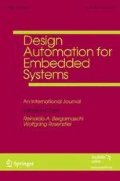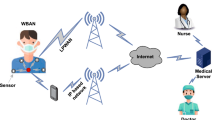Abstract
As wireless sensor network platforms become increasingly more complex to design and optimize due to the multitude of interdependent parameters that must be considered, computer simulations have emerged as the primary solution to feasibly analyze the long-term effects of design changes within a deployed system. Although several successful wireless sensor network simulators have already been developed, to our knowledge, none provide the modularity necessary to model sensor nodes and/or environmental components at differing levels of abstraction. In this paper, we present the Arizona Transaction-Level Simulator for Sensor Networks (ATLeS-SN), which by virtue of its implementation language—SystemC—allows application developers to easily specify interchangeable component models in order to achieve the desired simulation correctness, performance, and scalability. We provide an overview of our proposed simulation framework and highlight its benefits using a sound ranging application.















Similar content being viewed by others
References
Atmel Corporation (2009) Low Power 2.4 GHz Transceiver for ZigBee, IEEE 802.15.4, 6LoWPAN, RF4CE and ISM Applications. AT86RF230 datasheet
Boulis A (2011) Castalia a Simulator for Wireless Sensor Networks and Body Area Networks User’s Manual
Crossbow Technology, Inc. (2010). http://www.xbow.com
DPOP: ATLeS-SN. http://www2.engr.arizona.edu/~dpop/Main/ATLeSSN
Egea-Lopez E, Vales-Alonso J, Martinez-Sala A, Pavon-Mario P, Garcia-Haro J (2006) Simulation scalability issues in wireless sensor networks. IEEE Commun Mag 44(7):64–73
Fall K, Varadhan K (2011) The VINT Project
Forster A (2011) Implementation of the B-MAC Protocol for WSN MiXiM. In: 4th international workshop to be held in conjunction with Simutools
Harel D (1987) StateCharts: a visual formalism for complex systems. Sci Comput Program 8:231–274
Hiner J, Shenoy A, Lysecky R, Lysecky S, Gordon-Ross A (2010) Transaction-level modeling for sensor networks using SystemC. In: IEEE international conference on sensor networks, ubiquitous, and trustworthy computing (SUTC), pp 197–204
Hoffman T (2003) Smart Dust. Mighty motes for medicine, manufacturing, the military and more. Comput World
Imran M, Said AM, Hasbullah H (2010) A survey of simulators, emulators and testbeds for wireless sensor networks. In: International symposium in information technology (ITSim)
Jevtic M, Zogovic N, Dimic G (2009) Evaluation of wireless sensor network simulators. In: 17th telecommunications forum (TELFOR)
Korkalainen M, Sallinen M, Karkkainen N, Tukeva P (2009) Survey of wireless sensor networks simulation tools for demanding applications. In: Fifth international conference on networking and services (ICNS)
Levis P, Lee N, Welsh M, Culler D (2003) TOSSIM: accurate and scalable simulation of entire TinyOS applications. In: ACM conference on embedded networked sensor systems (SenSys)
Mann S (1997) Wearable computing: a first step toward personal imaging. Computer 30(2):25–32
Muller-Rathgeber B, Rauchfuss H (2008) A cosimulation framework for a distributed system of systems. In: IEEE vehicular technology conference (VTC), pp 1–5
Munir A, Gordon-Ross A, Lysecky S, Lysecky R (2010) A lightweight dynamic optimization methodology for wireless sensor networks. In: IEEE international conference on wireless and mobile computing, networking and communications (WiMob), pp 129–136
Munir A, Gordon-Ross A, Lysecky S, Lysecky R (2010) A one-shot dynamic optimization methodology for wireless sensor networks. In: International conference on mobile ubiquitous computing, systems, services (UBICOMM)
Perkins C, Royer EM (1997) Ad-hoc on-demand distance vector routing. In: Proceedings of the 2nd IEEE workshop on mobile computing systems and applications (MobiComm), pp 90–100
Polastre J, Hill J, Culler D (2004) Versatile low power media access for wireless sensor networks. In: Proceedings of the 2nd international conference on embedded networked sensor systems (SenSys), pp 95–107
Shenoy A, Hiner J, Lysecky S, Lysecky R, Gordon-Ross A (2010) Evaluation of dynamic profiling methodologies for optimization of sensor networks. IEEE Embed Syst Lett 2(1):10–13
Shnayder V, Hempstead M, Chen B, Allen G, Welsh M (2004) Simulating the power consumption of large-scale sensor network applications. In: ACM conference on embedded networked sensor systems (SenSys)
Sundresh S, Kim W, Agha G (2004) SENS: a sensor, environment and network simulator. In: Proceedings of the 37th annual symposium on simulation (ANSS)
Warneke B, Pister K (2004) An ultra-low energy microcontroller for smart dust wireless sensor networks. In: International solid state circuits conference (ISSCC)
Zhou G, He T, Krishnamurthy S, Stankovic JA (2004) Impact of radio irregularity on wireless sensor networks. In: Proceedings of the 2nd international conference on mobile systems, applications, and services (MobiSys), pp 125–138
Zuniga M, Krishnamachari B (2004) Analyzing the transitional region in low power wireless links. In: 1st Annual IEEE communications society conference on sensor and ad hoc communications and networks (SECON), pp 517–526
Author information
Authors and Affiliations
Corresponding author
Additional information
This work was supported by the National Science Foundation (CNS 0834102, CNS 0834080).
Rights and permissions
About this article
Cite this article
Lizarraga, A., Ding, L., Hiner, J. et al. ATLeS-SN. Des Autom Embed Syst 16, 265–291 (2012). https://doi.org/10.1007/s10617-013-9109-2
Received:
Accepted:
Published:
Issue Date:
DOI: https://doi.org/10.1007/s10617-013-9109-2




